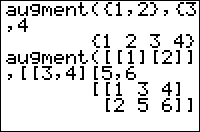TI-BASIC:Augment: Difference between revisions
Initial automated import |
Automated superscript correction |
||
| Line 31: | Line 31: | ||
= Advanced Uses = | = Advanced Uses = | ||
Use the | Use the <sup>[[TI-BASIC:Transpose|T]]</sup> (transpose) command if you want to combine two matrices vertically, rather than horizontally. For example: | ||
| Line 63: | Line 63: | ||
* [[TI-BASIC:Dim|Dim(]] | * [[TI-BASIC:Dim|Dim(]] | ||
* [[TI-BASIC:Seq_List|seq(]] | * [[TI-BASIC:Seq_List|seq(]] | ||
* | * <sup>T</sup> ([[TI-BASIC:Transpose|Transpose]])[[Category:TI-BASIC]] | ||
[[Category:TIBD]] | [[Category:TIBD]] | ||
Latest revision as of 22:24, 24 February 2016
Command Summary
Combines two lists or matrices into one. In the case of matrices, this is done horizontally rather than vertically.
Command Syntax
augment(list1,list2
augment(matrix1,matrix2
Menu Location
Press:
- 2nd LIST to access the List menu
- RIGHT to access the OPS submenu
- 9 to select augment(, or use arrows
Alternatively, press:
- MATRX (on the TI-83) or 2nd MATRX (TI-83+ or higher) to access the Matrix menu
- RIGHT to access the MATH submenu
- 7 to select augment(, or use arrows
TI-83/84/+/SE
1 byte
The augment( command is used to combine two lists or two matrices into one. For lists, this is done the obvious way: adding the elements of the second on to the elements of the first. For example:
augment({1,2,3,4},{5,6,7
{1 2 3 4 5 6 7}
For matrices, the columns of the second matrix are added after the columns of the first matrix: an R by C matrix augmented with an R by D matrix will result in an R by (C+D) matrix. For example:
augment([[1][2]],[[3][4] [[1 3] [2 4]]
Advanced Uses
Use the T (transpose) command if you want to combine two matrices vertically, rather than horizontally. For example:
augment(1,2T,3,4T)T [[1 2] [3 4]]
Optimization
You may be tempted to use augment( to add one element to the end of a list:
:augment(L1,{X→L1
However, the following way is faster and more memory-efficient while the program is running (although it increases the program's size):
:X→L1(1+dim(L1
Error Conditions
- ERR:DATA TYPE is thrown if you try to augment a single number to a list, a common error -- use {X instead of X.
- ERR:DIM MISMATCH is thrown if you try to augment two matrices with a different number of rows.
- ERR:INVALID DIM is thrown if one of the arguments is a list with dimension 0, or if the result would have dimension over 999 (for lists) or 99x99 (for matrices).
